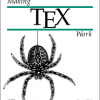Free Online Productivity Tools
i2Speak
i2Symbol
i2OCR
iTex2Img
iWeb2Print
iWeb2Shot
i2Type
iPdf2Split
iPdf2Merge
i2Bopomofo
i2Arabic
i2Style
i2Image
i2PDF
iLatex2Rtf
Sci2ools
Book
Making TeX Work
"TeX is a tool for creating professional quality, typeset pages of any kind. It is particularly good, perhaps unsurpassed, at typesetting mathematics ; as a result, it is widely used in scientific writing. Some of its other features, like its ability to handle multiple languages in the same document and the fact that the content of a document (chapters, sections, equations, tables, figures, etc.) can be separated from its form (typeface, size, spacing, indentation, etc.) are making TeX more common outside of scientific and academic circles.
Designed by Donald Knuth in the late 1970s, more than a decade of refinement has gone into the program called “TeX” today. The resulting system produces publication-quality output while maintaining portability across an extremely wide range of platforms.
Remarkably, TeX is free. This fact, probably as much as any other, has contributed to the development of a complete “TeX system” by literally thousands of volunteers. TeX, the pro...
Latex |
Related Content
| Added | 18 Feb 2009 |
| Updated | 18 Feb 2009 |
| Authors | NormanWalsh |
Table of Content
Why Read This Book?Scope of This Book
Conventions Used in This Book
How to Get TeX
Where Are the Files?
Getting Software Without FTP
Getting Examples From This Book
Versions of TeX
Implementations and Platforms
UNIX
MS-DOS
OS/2
Macintosh
We'd Like to Hear From You
Acknowledgments
I. An Introduction to TeX
1. The Big Picture
What Is TeX?
TeX for Beginners
Boxes and Glue
Control Sequences
Special Characters
Text Formatting Versus Word Processing
What About Desktop Publishing?
What About troff?
What About SGML?
How TeX Works
TeXing a Simple Document
TeXing More Complex Documents
Building a Table of Contents
Figure References
Indexes and Glossaries
Bibliographies
Special Things
2. Editing
What Can an Editor Do?
Quoting Automatically
Matching Braces
Inserting Common Control Sequences
Running TeX Automatically
GNU Emacs
Starting TeX Mode
Typing in Emacs
Running TeX Automatically
aucTeX
Starting aucTeX
Typing in aucTeX
aucTeX Outline Mode
Intelligent Paragraph Reformatting
Multi-file Documents
Running TeX
Finding Errors
Multi-Edit
Setting Up TeX Support
Typing in Multi-Edit
Running TeX
Brief
MicroEMACS
epm: OS/2's Enhanced Editor
Other Tools
TeX as a Compiler
Processing a Document
Spellchecking
ispell
amSpell
Revision Control
TeX Shells
TeXShell
TeXPert
4TeX
PMTeX
TeXit
3. Running TeX
What Do You Run?
What Files Does TeX Need?
Pool Files
Format Files
User Files
The Command Line
Command-line Options
Command-line Cautions
TeX Without Options
What About Errors?
Log Files
Interpreting TeX Error Messages
Naming a File TeX Cannot Find
Misspelling a Control Sequence Name
Failure to Close an Environment
Math Outside of Math Mode
Missing Fonts
Everything Else
The Question Mark Prompt
4. Macro Packages
Installation: Making Format Files
Hyphenation Patterns
General-purpose Formats
Plain TeX
Extended Plain TeX
LaTeX2e Versus LaTeX
LaTeX2e
LaTeX
AMSTeX
AMSLaTeX
Lollipop
TeXinfo
Other Formats
Special-purpose Formats
SliTeX
FoilTeX
Seminar
TeX in Color
Setting Up Color
Using Color
Now I've Got Color, but I Need Black and White!
Color Under LaTeX2e
Color Is Subtle
Further Reading
II. Elements of a Complex Document
5. Fonts
What TeX Needs To Know
Selecting a Font in TeX
Which Character Is Which?
The Issue of Size
Expressing Design Size in TeX
Expressing Magnification in TeX
Standard Magnifications
Where Do TFM Files Come From?
The New Font Selection Scheme
Selecting Fonts with the New Font Selection Scheme
Defining Fonts with NFSS2
Storing Font Definitions
Changing the Defaults
NFSS Pitfalls
PostScript Fonts Under NFSS
Adjustments to Scale
When Things Go Wrong
When TeX Complains
When the DVI Driver Complains
Encoding Vectors
Virtual Fonts
Automatic Font Generation by DVI Drivers
Math Fonts in TeX
Concrete Examples
MetaFont Fonts
PostScript Type 1 Fonts
HP LaserJet Softfonts
TrueType Fonts
6. Pictures and Figures
Different Kinds of Images
Bitmapped Images
Scalable Images
Device Independence Revisited
Using Only TeX
Plain TeX
LaTeX
PiCTeX
XYPic
DraTeX
Using a Little Help
Comments (0)



